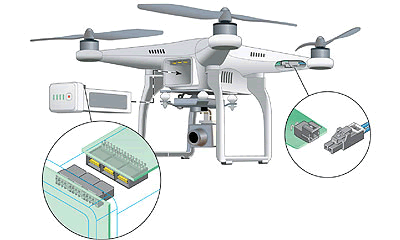Connectors Help UAV Markets Soar
The growing number of commercial drones creates demand for connectors that enable quick swapping of batteries and storage.
By Terry Costlow, Contributing Editor
The takeoff of the unmanned aerial vehicle (UAV) market in areas beyond defense deployments is opening a solid growth market for connector suppliers that can provide compact, lightweight products to commercial and industrial users. Reliability and versatility are also requirements for connectors that let operators quickly land UAVs, swap out sensors, memory modules, and battery packs, then resume flying.

Military users have pioneered techniques that enable quick change-outs of sensors and other modules.
Though military applications have dominated the use of drones, businesses are now seeing the benefits of aerial observation. Drones are rapidly expanding beyond the military market, addressing a range of industrial applications including: oil and gas, construction, warehouse inventory, forestry, mining, utilities, and agriculture.
BI Intelligence expects commercial drone shipments to soar to 805,000 in 2021, a CAGR of 51%. There are several niches within this category. Oil and gas exploration and production are among the fields that are already utilizing UAVs, and construction and security have adopted drone technology as well.
Agriculture is expected to be one of the largest non-defense markets. Zion Market Research pegged the agriculture drone market at $673 million in 2015, predicting that growth will surpass 25% through 2021, when revenues could hit $2.98 billion. UAVs let farmers monitor crops and livestock. Some studies have also shown significant improvements in yields when drones use infrared cameras and other sensors to provide data on moisture levels and growth, allowing farmers to adjust irrigation and target fields on a microclimate level.
These new markets share many of the traits of defense industry UAVs. One of the most critical is that users want to keep them flying, not sitting on the ground. Connectors play a major role in decreasing downtime, making it easier for users to land vehicles and replace battery and memory modules. Reliable connections are mandatory in this harsh environment.
“Users want to plug and replug modules so they can pull out a storage module and put in a new, empty module, and quickly get the UAV flying again,” said Bob Stanton, director, Omnetics. “Nano-D latching connectors meet the requirements for mates and demates, and they hold as tight as the old connectors with jack screws.”
This focus on making quick, reliable exchanges extends to the batteries that power these aircraft. For example, Molex is promoting its EXTreme Power products, which provide from 30 to 150 amps per circuit. These high-current/high-density connectors have low profiles to facilitate cooling. The line is also modular, so system engineers can create configurations that meet their specific requirements.

Molex products help drone users quickly swap out battery modules.
This ability to customize is important, given the many diverse applications in which drones are used. While many commercial buyers will be able to employ standard connectors, some will have requirements that can only be met with customized products. That won’t be a problem for suppliers who have developed modeling and simulation techniques that have helped them modify connectors for military users and other low-volume applications.
“Companies will need something like a standard component, but they need something extra,” Stanton said. “With modeling and 3D printing, we can collaborate on a design, then quickly create a part they can use for a physical check.”

Omnetics uses modeling to quickly adapt connectors to meet user demands.
The aircraft themselves are only part of the market for connector suppliers. The cameras, radar, thermal imagers, and other sensors also represent a growing market. Research and Markets predicts that aircraft sensors will grow from $1.68 billion in 2017 to $2.25 billion by 2022, representing a CAGR of 6.01%.
At present, the bulk of the market is in the US, as are the manufacturers. Technavio noted that many major suppliers, including: Lockheed Martin, Aurora Flight Sciences, General Atomics, Northrop Grumman, and AeroVironment, are in the US, which should foster market growth in the Americas.
Regardless of where or how UAVs are deployed, reliability is a critical performance parameter for connectors. Shock can come into play with smaller drones, which often don’t land particularly smoothly. Vibration can become more of an issue in larger drones that stay aloft for hours.
Speed is also becoming more of an issue as cameras and radar move to higher resolutions. Today’s compact CMOS cameras generate hundreds of megabytes per second, so storage requirements can run into the hundreds of gigabytes for many runs, depending on flight time and camera resolution. Most commercial applications are likely to store data on the drone rather than transmitting image data to ground stations, as continuous communication is more expensive than employing reusable memory modules. In applications that collect sensitive data, storage modules provide more security. Transmitted signals can be intercepted, while the only way to glean information from memory modules is to steal them.
Recently posted:
[related_posts limit=”10″]
- State of the Industry: 2022-2023 Connector Sales - April 16, 2024
- Amphenol is On a Roll - April 2, 2024
- Nicomatic Proves That Two Heads are Better Than One - March 26, 2024






